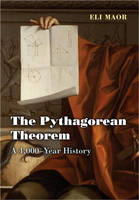
The Pythagorean Theorem
Princeton University Press (Verlag)
978-0-691-12526-8 (ISBN)
- Titel erscheint in neuer Auflage
- Artikel merken
By any measure, the Pythagorean theorem is the most famous statement in all of mathematics, one remembered from high school geometry class by even the most math-phobic students. Well over four hundred proofs are known to exist, including ones by a twelve-year-old Einstein, a young blind girl, Leonardo da Vinci, and a future president of the United States. Here - perhaps for the first time in English - is the full story of this famous theorem. Although attributed to Pythagoras, the theorem was known to the Babylonians more than a thousand years before him. He may have been the first to prove it, but his proof - if indeed he had one - is lost to us. Euclid immortalized it as Proposition 47 in his Elements, and it is from there that it has passed down to generations of students. The theorem is central to almost every branch of science, pure or applied. It has even been proposed as a means to communicate with extraterrestrial beings, if and when we discover them. And, expanded to four-dimensional space-time, it plays a pivotal role in Einstein's theory of relativity.
In this book, Eli Maor brings to life many of the characters that played a role in the development of the Pythagorean theorem, providing a fascinating backdrop to perhaps our oldest enduring mathematical legacy.
Eli Maor teaches the history of mathematics at Loyola University in Chicago. He is the author of "Venus in Transit, Trigonometric Delights, e: The Story of a Number", and "To Infinity and Beyond: A Cultural History of the Infinite" (all Princeton).
List of Color Plates ix Preface xi Prologue: Cambridge, England, 1993 1 Chapter 1: Mesopotamia, 1800 bce 4 Sidebar 1: Did the Egyptians Know It? 13 Chapter 2: Pythagoras 17 Chapter 3: Euclid's Elements 32 Sidebar 2: The Pythagorean Theorem in Art, Poetry, and Prose 45 Chapter 4: Archimedes 50 Chapter 5: Translators and Commentators, 500-1500 ce 57 Chapter 6: Franois Vite Makes History 76 Chapter 7: From the Infinite to the Infinitesimal 82 Sidebar 3: A Remarkable Formula by Euler 94 Chapter 8: 371 Proofs, and Then Some 98 Sidebar 4: The Folding Bag 115 Sidebar 5: Einstein Meets Pythagoras 117 Sidebar 6: A Most Unusual Proof 119 Chapter 9: A Theme and Variations 123 Sidebar 7: A Pythagorean Curiosity 140 Sidebar 8: A Case of Overuse 142 Chapter 10: Strange Coordinates 145 Chapter 11: Notation, Notation, Notation 158 Chapter 12: From Flat Space to Curved Spacetime 168 Sidebar 9: A Case of Misuse 177 Chapter 13: Prelude to Relativity 181 Chapter 14: From Bern to Berlin, 1905-1915 188 Sidebar 10: Four Pythagorean Brainteasers 197 Chapter 15: But Is It Universal? 201 Chapter 16: Afterthoughts 208 Epilogue: Samos, 2005 213 Appendixes 219-237 Chronology 241 Bibliography 247 Illustrations Credits 251 Index 253
| Erscheint lt. Verlag | 10.6.2007 |
|---|---|
| Zusatzinfo | 8 color plates. 141 line illus. 2 tables. |
| Verlagsort | New Jersey |
| Sprache | englisch |
| Maße | 152 x 235 mm |
| Gewicht | 624 g |
| Themenwelt | Mathematik / Informatik ► Mathematik ► Allgemeines / Lexika |
| Mathematik / Informatik ► Mathematik ► Geometrie / Topologie | |
| Mathematik / Informatik ► Mathematik ► Geschichte der Mathematik | |
| Mathematik / Informatik ► Mathematik ► Mathematische Spiele und Unterhaltung | |
| ISBN-10 | 0-691-12526-0 / 0691125260 |
| ISBN-13 | 978-0-691-12526-8 / 9780691125268 |
| Zustand | Neuware |
| Haben Sie eine Frage zum Produkt? |
aus dem Bereich



